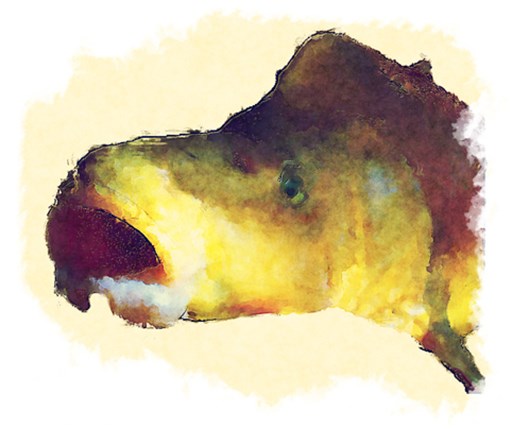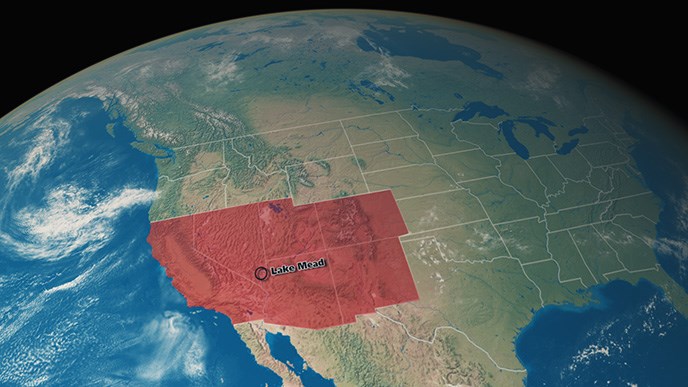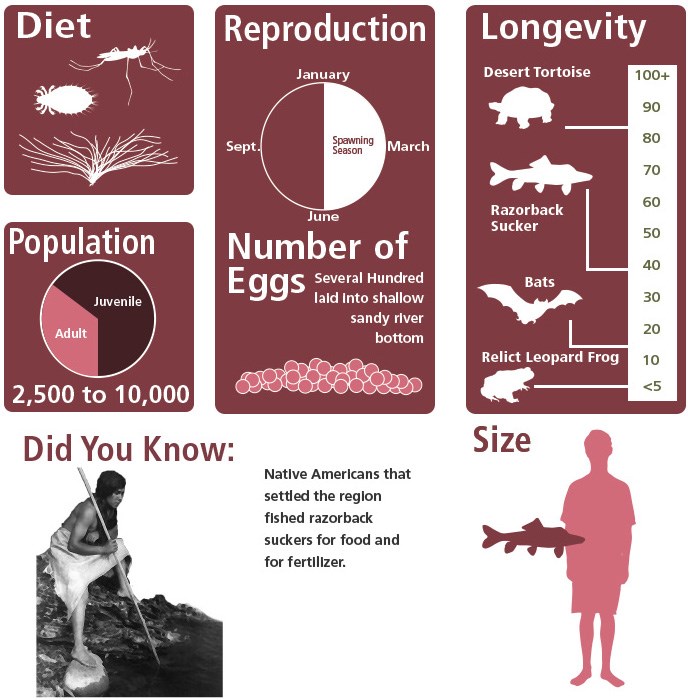
The razorback sucker is endemic to the Colorado River basin and was listed as an endangered species in 1991. Populations are currently in decline throughout the Colorado River basin and have decreased markedly during the last two decades in the lower basin, particularly in Lake Mohave. Razorback suckers are restricted to a relatively small number of sites in the Colorado River system, from southwestern Wyoming to southeastern California. Xyrauchen texanus has a more stable population in the lower basin of the Colorado River than the upper basin. Within the lower basin, Lake Mohave, Arizona contains the greatest population of razorback suckers. They are also found in Lake Mead and the Grand Canyon, as well as in some associated canals and impoundments (Gilbert and Williams, 2002). In the upper basin of the Colorado River, the largest surviving population is found in the Green and Yampa rivers.
Razorback suckers were once much more abundant and widely distributed. Xyrauchen texanus was found throughout the Colorado River and its major tributaries. As recent as the 1920's, human activities - such as dam builing - have degraded and destroyed the physical and biological components of the habitat of X. texanus and are directly responsible for the geographic range decline of this species.

Range Map

An ongoing stocking program is attempting to enhance the number of suckers that reach maturity in Lake Mohave where young fish escape predation by non-native fishes. Since the early 1980's, the USFWS and Arizona Game and Fish Department have attempted to establish populations in the Gila, Verde and Salt rivers through stocking, but no fish survive in the long-term. In the upper Colorado River Basin, adults and larvae are widely distributed in the Green River basin, especially in the upper basin from the mouth of the Duchesne River, upstream to the lower 4miles of the Yampa River, rarely occurring upstream as far as the Little Snake River. Spawning has been documented in lower Yampa River near the confluence with Green River and in the upper Green River. Fast Facts
Interesting FactsThe Colorado River was once an environment of extremes. The river flooded each spring as the Rocky Mountain snow pack melted, bringing with it millions of tons of sediment. It was warm, even hot, in late summer as runoff decreased, and in the winter it was shallow and cold. The native fish that inhabited the river were well adapted to these physical and chemical extremes. The construction of mainstream dams reduced the sediment in the river, allowing sunlight to penetrate through the water and produce an abundance of algae and plant growth. Without the abrasive sediments, small animals were able to colonize the riverbed and bank lines as well as the newly formed reservoirs. Introduced fish species such as carp, largemouth bass, channel catfish, and various sunfishes took advantage of these new plant and animal food sources and quickly established and expanded their populations. Native fish like the razorback sucker were not well adapted to these biological changes, and their populations slowly declined. The razorback, which is native to North America and found only in the Colorado River Basin, has been around for tens of thousands of years. But few people have seen this fish. Once abundant in the turbulent and unpredictable Colorado River, the razorback sucker is now restricted to a few remnant populations, the largest of which can be found in Lake Mohave. Several thousand old (generally in excess of 40 years of age) razorback suckers spawn in Lake Mohave but few, if any, of the young fish survive to reach adulthood. This is because the eggs are eaten by carp, sunfish, trout, and many other species of fish. Those that do hatch often become food for young sunfish and other game fish. This fact did not help the 60% population decline from 59,508 in 1988 to 23,313 in 1992. After the razorback was put on the endangered species list in 1991, several organizations began to try to help this fish. Each year, using lights and dip nets, biologists of the work group collect wild razorback sucker larvae at spawning grounds in February and March. The larval fish are held in a laboratory for three weeks until they reach one inch in length. The young sucker larvae are then stocked into predator-free isolated rearing coves around the lake or in other locations like the Boulder City, Nevada, golf course or Willow Beach National Fish Hatchery. When the fish are between 8 and 12 inches long and able to avoid most predators, they are released into the lake. At this size, scientists believe that they are big enough to escape predators and live out the rest of their 50 year life span. Since the first razorback suckers were released into Lake Mohave in 1992, more than 30,000 juvenile razorbacks have been successfully raised and returned to the wild, and more than 100,000 are being reared for release back to the lake. About 50 percent of the fish that have been restocked are believed to be successfully spawning, and fishery biologists believe these fish will help replace the aging population that now inhabits the lake, ensuring the species' continuation. References
Threat Level provided by the International Union for Conservation of Nature's (IUCN) Red List.http://www.iucnredlist.org/
|
Last updated: December 14, 2022
